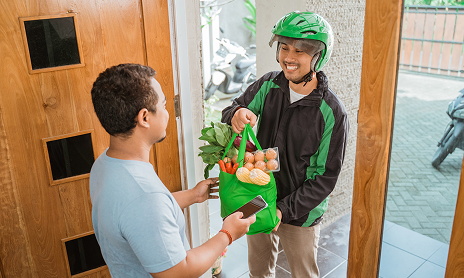
Delivery App
Simplify your delivery operations with a feature-rich app designed for efficiency and convenience. Manage orders, track deliveries, and ensure seamless communication between customers and drivers—all in one intuitive platform.
Delivery App: Revolutionizing Your Delivery Experience.
Introduction
A delivery app is a smartphone application created to make the ordering, tracking, and management of goods and services delivery processes as convenient as possible. It functions as a digital hub that links clients, companies, and delivery staff, facilitating easy coordination and communication. Delivery applications are becoming necessary tools for both consumers and businesses in the fast-paced world of today, where speed and convenience are crucial. From the comfort of their smartphones, customers can use these applications to browse products, place orders, and get real-time information on their deliveries. Live tracking and rapid notifications offer transparency, which improves user experience and fosters happiness and confidence.
Delivery applications are not simply useful for logistics; they also spur productivity and expansion for companies. Businesses can increase their efficiency and reach a wider audience by streamlining delivery routes, handling orders in real time, and obtaining insightful customer data. Because of its adaptability, delivery applications can be utilized in a variety of sectors, including e-commerce, healthcare, food, and grocery delivery. They are invaluable in today's business due to their versatility.
 1. What is a Delivery Management System?
1. What is a Delivery Management System?
Defining its Importance
A delivery app's primary function is to improve the delivery procedure as a whole. Consumers may conveniently look through merchandise, place orders, and get delivery progress details while relaxing on their personal mobile device. Using a centralized system to manage orders, track deliveries, and optimize logistics is beneficial for businesses. On the other side, delivery staff utilize the app to get assignments, find their way around and check on the status of deliveries. Each and every stakeholder in the delivery process is informed and involved thanks to this interconnected system.
The fast-paced lifestyle of today has led to high demands from consumers. Reliability, speed, and openness are now essential components of a satisfying client experience. These needs are met by delivery applications, which offer rapid notifications, anticipated arrival times, and real-time tracking. Consumers can now follow their orders live on a map, get information on any delays, and know exactly when to expect their delivery, eliminating any need for them to wonder when their purchase will arrive. This degree of accessibility increases client satisfaction and trust, which makes it an essential component of modern business.
 2. Key Features of Delivery App
2. Key Features of Delivery App
Order Tracking:
Customers and organizations may track the status of delivery in real time with order tracking. Users may view the precise location of their delivery, get updates on its status, and check the projected arrival timings thanks to GPS integration. Because customers can always track the whereabouts of their orders, this function improves efficiency and increases trust.
Delivery Scheduling:
Users can plan delivery times at their convenience with this feature. Delivery schedule offers options for both immediate delivery and future planning. Companies are able to maximize delivery routes and times, and customers get to pick when they want their items delivered.
Notifications:
Throughout the delivery process, notifications keep everyone updated. Order confirmations, dispatch, projected delivery times, and any delays are all reported to customers through alerts. Delivery employees are updated about new assignments, and order statuses are sent to businesses. Constant information flow guarantees seamless operations and improves user experience.
Order Management:
A consolidated platform for order management enables companies to effectively manage every order. Based on various factors such as status, priority, and delivery time, it can be used for tracking, sorting, and filtering orders. Businesses can improve efficiency, lower mistakes, and guarantee on-time delivery with the aid of this function.
Business Dashboard:
An overview of all delivery-related operations is displayed in the business dashboard, which also includes data on the number of orders, performance metrics, and delivery efficiency. Companies may enhance their delivery procedures by analyzing data, monitoring KPIs, and taking well-informed decisions. An essential tool for monitoring operations is the dashboard.
 3. Benefits of a Delivery Management System
3. Benefits of a Delivery Management System
The operational effectiveness, customer happiness, and overall profitability of a business can all be significantly increased with the help of a delivery management system. The ability to optimise the entire delivery process—from order placement to final delivery—is one of the main benefits. Businesses may lower human error, improve delivery routes, and guarantee on-time deliveries by automating processes including dispatching, route planning, and real-time tracking. Because of the reduced fuel usage and labor expenses resulting from more efficient operations, there are significant cost savings.
Moreover, a delivery management system improves communication and transparency through offering clients access to real-time order updates and live delivery tracking. Customers feel better informed and in charge of the delivery process, which increases customer satisfaction and fosters loyalty and trust. Additionally, the system is flexible, allowing companies to manage a rise in the number of orders they receive without sacrificing the quality of their services.
Establishing a strong delivery management system is crucial in a competitive market to keep a competitive edge, guarantee customer happiness, and promote long-term company success.
 4. Design Elements of the Delivery App
4. Design Elements of the Delivery App
A delivery app's design is crucial to delivering a satisfying user experience, which in turn affects user engagement and customer satisfaction. To ensure that users can navigate the app with ease, place orders, and track deliveries without confusion, intuitive navigation is crucial. Usability is improved with a well-designed interface that leads consumers through every step with ease. Just as crucial is responsive design, which ensures that the application runs without any problems on a range of screens, including desktop, tablet, and smartphone ones.
For information to be communicated efficiently and rapidly, clean designs are essential. Users may quickly determine the status of their orders by using maps, symbols, and status indications, which eliminates the need for speculation. Another important component of the design is customisation, which gives companies the ability to match the app's appearance to their corporate identity, giving the product a unified and polished image.
 5. How Implementing A Delivery Management System Affects Your Business
5. How Implementing A Delivery Management System Affects Your Business
A company's operations can become more efficient, customers will become more loyal, and the company will gain a competitive advantage with the implementation of a delivery management system. Deliveries become faster and more precise when delivery processes are automated because it drastically cuts down on human labor and time. This efficiency minimizes errors and operating expenses while streamlining procedures. Better delivery experiences, made possible by dependable service and real-time tracking, directly boost customer happiness and loyalty, promoting recommendations and repeat business. Furthermore, a delivery management system may be an important differentiation in a crowded market since it allows a company to stand out from rivals by providing better service and dependability.
 6. The Evolution of Delivery Management System
6. The Evolution of Delivery Management System
From manual procedures to complex digital platforms, delivery management systems have developed over time. Delivery tracking began with phone calls and paper diaries, which were labor-intensive and prone to mistakes. Systems became increasingly automated with the introduction of technology, integrating real-time data analytics, automatic notifications, and GPS monitoring. AI and machine learning are being integrated into delivery management systems to estimate delivery times, optimize routes, and offer individualized experiences.
 7. Delivery Apps & its Future
7. Delivery Apps & its Future
A number of innovative trends and technology developments are about to completely change the delivery app landscape. At the forefront are machine learning and artificial intelligence (AI), which allow for more intelligent route planning, predictive analytics, and highly customized user experiences. By streamlining processes, increasing delivery precision, and customizing services to each client's preferences, these technologies will raise customer satisfaction levels all around. Drone and autonomous car technological advancements promise to further upend the sector by lowering the need for human interaction and potentially enabling faster, more effective delivery times. In tandem with these developments, sustainability is becoming more and more important, with an emphasis on environmentally friendly delivery methods like electric cars and eco-friendly packaging.
This change is a result of growing environmental consciousness and the desire for more environmentally friendly activities. Another major trend is multichannel integration, which attempts to offer a smooth experience on several platforms (web, mobile, and in-store) so that clients receive consistent service. Furthermore, the growing popularity of regional deliveries, especially in cities satisfy the need for quick, around-the-clock services. These advancements are expected to improve efficiency and convenience, reshaping the delivery sector and creating new opportunities for both customers and companies.
















